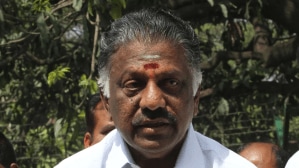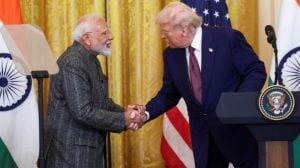A 60-acre of urban green space, Byculla zoo is a result of planning that took shape 160 years ago
The existence of a zoo inside a botanical park is also a testament to Mumbai’s age-old culture of being an egalitarian society, despite being a power centre during British rule in India.
 The zoo was established in 1962 almost three decades after the gardens were set up. Amit Chakravarty
The zoo was established in 1962 almost three decades after the gardens were set up. Amit ChakravartyWHAT IS today a 60 acre of urban green space housing a botanical garden and zoo in the heart of Mumbai, the Veermata Jijabai Bhosale Udyan and Zoo in Byculla is a result of meticulous urban planning that took shape 160 years ago.
The existence of a zoo inside a botanical park is also a testament to Mumbai’s age-old culture of being an egalitarian society, despite being a power centre during British rule in India.
Erstwhile Victoria Gardens, now Byculla zoo was originally intended as a pleasure ground. The zoo was established in 1962 almost three decades after the gardens were set up, according to the Gazetteer of Bombay City, Volume III, 1910.
At its peak in the early 1900s, the zoo housed rare animals like the rare black panther, puma, African antelope, Himalayan black bear, llamas, kangaroos, elephants, emus and ostriches.
The areas of Mazgaon formed a portion of Mazagaon Island, and sometime in the 1690s, the island was joined with the Island of Bombay. Following this, several British officers began to move away from the crowded areas of Fort towards what would have been like suburbs at the time — Mazgaon and Byculla — according to Bharat Gothoskar, a city chronicler.
Several wealthy Indian families like Sassoons, Jeejeebhoys, and Shankarshets also had palatial homes in this area, Gothoskar said. Around 1860, 33 acres of a certain “useless and low-lying land of Mount Estate in Mazgaon” was decided to be converted into a garden and pleasure ground. According to the Gazetteer, the government at the time handed over this land to the Agri-Horticultural Society of Western India, which was to maintain the gardens.
On November 19, 1862, Lady Catherine Frere formally threw open the Victoria Gardens to the public. By 1873, the Agri-Horticultural Society of Western India ceased to exist, and the gardens officially began to be maintained by the Municipal Corporation. However, it was not until 1890 (28 years later) that 15 acres were added to the Victoria Gardens for the development of a zoo.
According to the Gazetteer, despite the well-stocked and refreshing rare species of tropical trees and plants, “the chief attraction to poorer classes of the city is the zoological collection.”
By 1910, there were over 24 kinds of animals in the zoo, including tiger, lion, panthers and black panthers, nilghai, hog deer, spotted deer, sambhar, gazelle, tortoises, crocodiles, rhea and cassowary.
“The inclusion of a zoo is likely to have taken place, as with industrialisation of the city, working-class Indians also began to live around Byculla and Mazgaon, and British officials began to shift to Malabar Hill,” Gothoskar said. The premises of Victoria Gardens remained open from sunrise to 7 pm, and till 10 pm on ‘moonlight nights’ and entry was free of charge.
“During this time, the Byculla area was bustling with activity. The Byculla vegetable market had come up and the Byculla Station nearby had recently been built. The Elphinstone college got its building at Byculla, opposite the present-day zoo, somewhere in the 1870s,” Gothoskar said.
Even though the Victoria Gardens was founded in the 1860s, the original botanical garden existed in Sewri since 1835, when the government granted a large plot of land to the Agri-Horticulture Society of Western India for a botanical garden. However, plans to shift it to Mazgaon began as the government decided to set up a European Cemetery on the plot.
According to Gothoskar, “Mazagaon Island is likely to have developed from the east of present-day Mumbai to the west, as the ports were on the eastern side. However, with time, the Sewri area is likely to have become ‘outskirts’ and hence the decision could have been taken to convert the original botanical garden into a cemetery.”
Following this, in July 1962, all the plants were shifted from Sewri to Victoria Gardens and new species of plants were also added. The garden at the time had 1,800 trees from 150 species, according to the Gazetteer.
Hutokshi Rustomfram, a trustee of the Save Rani Bagh Botanical Garden Foundation, said, “From the day it was inaugurated it was meant for
the citizens of Bombay. One of the reasons the Botanical garden, which was by then laid
out beautifully, was shifted from Sewri to Byculla was that people could not visit the garden in Sewri. They also declared a half-day holiday in the city, so workers could attend the inauguration.”
In 1969, the Victoria Gardens was renamed Veermata Jijabai Bhosale Udyan, and in 1980, it was renamed Veermata Jijabai Bhosale Udyan va Pranisangrahalaya (Zoo). The precinct of the zoo is a Grade II-B heritage structure. Now there are 4,131 trees of 256 species, which constitutes 80 per cent of Mumbai’s flora.
In September 2022, the state government’s Urban Development Department approved the Brihanmumbai Municipal Corporation’s (BMC) development plan proposal that created a new designation “Botanical Garden”, especially for the Veermata Jijabai Bhosale Udyan and Zoo.
Rustomfram said, “We have now proposed that the VJB Udyan and Zoo must be renamed Veermata Jijabai Bhosale Vanaspati Udyan va Pranisangrahalay, including the botanical garden in its official name. The process has begun and has been endorsed by the municipal commissioner.”












